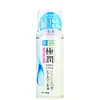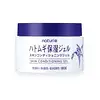What's inside
What's inside
 Key Ingredients
Key Ingredients

 Benefits
Benefits

 Concerns
Concerns

 Ingredients Side-by-side
Ingredients Side-by-side

Water
Skin ConditioningGlycerin
HumectantCaprylic/Capric Triglyceride
MaskingDipropylene Glycol
HumectantSqualane
EmollientC20 Olefin
PPG-10 Methyl Glucose Ether
Skin ConditioningHydrolyzed Hyaluronic Acid
HumectantSodium Hyaluronate
HumectantPEG-20 Sorbitan Isostearate
EmulsifyingGlyceryl Stearate
EmollientDimethicone
EmollientStearyl Alcohol
EmollientCarbomer
Emulsion StabilisingBehenyl Alcohol
EmollientPhytosteryl/Octyldodecyl Lauroyl Glutamate
Skin ConditioningMelaleuca Alternifolia Leaf Oil
AntioxidantDisodium EDTA
Methylparaben
PreservativePropylparaben
PreservativeWater, Glycerin, Caprylic/Capric Triglyceride, Dipropylene Glycol, Squalane, C20 Olefin, PPG-10 Methyl Glucose Ether, Hydrolyzed Hyaluronic Acid, Sodium Hyaluronate, PEG-20 Sorbitan Isostearate, Glyceryl Stearate, Dimethicone, Stearyl Alcohol, Carbomer, Behenyl Alcohol, Phytosteryl/Octyldodecyl Lauroyl Glutamate, Melaleuca Alternifolia Leaf Oil, Disodium EDTA, Methylparaben, Propylparaben
Water
Skin ConditioningGlycerin
HumectantDipropylene Glycol
HumectantDimethicone
EmollientTetrahexyldecyl Ascorbate
AntioxidantTocopheryl Phosphate
CleansingCoix Lacryma-Jobi Ma-Yuen Seed Extract
Skin ConditioningCholesteryl/Octyldodecyl Lauroyl Glutamate
Skin ConditioningAcrylates/C10-30 Alkyl Acrylate Crosspolymer
Emulsion StabilisingAmmonium Acryloyldimethyltaurate/Vp Copolymer
Butylene Glycol
HumectantPEG-12 Dimethicone
Skin ConditioningSodium Hydroxide
BufferingCarbomer
Emulsion StabilisingPhytosteryl Isostearyl Dimer Dilinoleate
EmollientOctyldodecyl Myristate
EmollientTocopherol
AntioxidantMethylparaben
PreservativeWater, Glycerin, Dipropylene Glycol, Dimethicone, Tetrahexyldecyl Ascorbate, Tocopheryl Phosphate, Coix Lacryma-Jobi Ma-Yuen Seed Extract, Cholesteryl/Octyldodecyl Lauroyl Glutamate, Acrylates/C10-30 Alkyl Acrylate Crosspolymer, Ammonium Acryloyldimethyltaurate/Vp Copolymer, Butylene Glycol, PEG-12 Dimethicone, Sodium Hydroxide, Carbomer, Phytosteryl Isostearyl Dimer Dilinoleate, Octyldodecyl Myristate, Tocopherol, Methylparaben
 Reviews
Reviews

Ingredients Explained
These ingredients are found in both products.
Ingredients higher up in an ingredient list are typically present in a larger amount.
Carbomer is a polymer of acrylic acid. Its main role is to create a gel consistency.
A high amount of carbomer can cause pilling or balling up of products. Don't worry, most products contain 1% or less of carbomer.
Dimethicone is a type of synthetic silicone created from natural materials such as quartz.
What it does:
Dimethicone comes in different viscosities:
Depending on the viscosity, dimethicone has different properties.
Ingredients lists don't always show which type is used, so we recommend reaching out to the brand if you have questions about the viscosity.
This ingredient is unlikely to cause irritation because it does not get absorbed into skin. However, people with silicone allergies should be careful about using this ingredient.
Note: Dimethicone may contribute to pilling. This is because it is not oil or water soluble, so pilling may occur when layered with products. When mixed with heavy oils in a formula, the outcome is also quite greasy.
Learn more about DimethiconeDipropylene Glycol is a synthetically created humectant, stabilizer, and solvent.
This ingredient helps:
Dipropylene glycol is technically an alcohol, but it belongs to the glycol family (often considered part of the ‘good’ alcohols). This means it is hydrating and gentle on skin unlike drying solvent alcohols like denatured alcohol.
As a masking agent, Dipropylene Glycol can be used to cover the smell of other ingredients. However, it does not have a scent.
Studies show Dipropylene Glycol is considered safe to use in skincare.
Learn more about Dipropylene GlycolGlycerin is already naturally found in your skin. It helps moisturize and protect your skin.
A study from 2016 found glycerin to be more effective as a humectant than AHAs and hyaluronic acid.
As a humectant, it helps the skin stay hydrated by pulling moisture to your skin. The low molecular weight of glycerin allows it to pull moisture into the deeper layers of your skin.
Hydrated skin improves your skin barrier; Your skin barrier helps protect against irritants and bacteria.
Glycerin has also been found to have antimicrobial and antiviral properties. Due to these properties, glycerin is often used in wound and burn treatments.
In cosmetics, glycerin is usually derived from plants such as soybean or palm. However, it can also be sourced from animals, such as tallow or animal fat.
This ingredient is organic, colorless, odorless, and non-toxic.
Glycerin is the name for this ingredient in American English. British English uses Glycerol/Glycerine.
Learn more about GlycerinMethylparaben is a preservative and is a paraben. It is used to prevent the growth of fungus, mold, and other harmful bacteria. Parabens are chemicals used as preservatives in both cosmetics and food.
Methylparaben can be synthetically created. It can also be found naturally in some fruits, such as blueberries.
Oftentimes, Methylparaben is combined with other parabens to help increase the shelf life.
The safety of Methylparaben is currently being studied. While ongoing studies are looking into the safety of parabens, the results have been very mixed. Some studies have not found Methylparaben to be harmful.
Learn more about MethylparabenWater. It's the most common cosmetic ingredient of all. You'll usually see it at the top of ingredient lists, meaning that it makes up the largest part of the product.
So why is it so popular? Water most often acts as a solvent - this means that it helps dissolve other ingredients into the formulation.
You'll also recognize water as that liquid we all need to stay alive. If you see this, drink a glass of water. Stay hydrated!
Learn more about Water